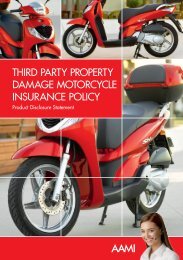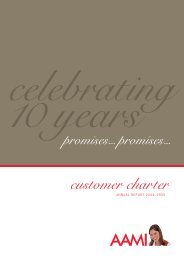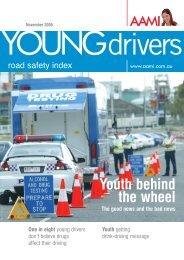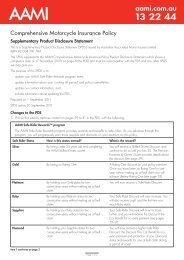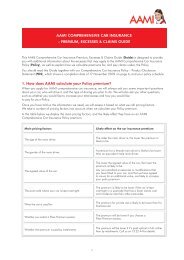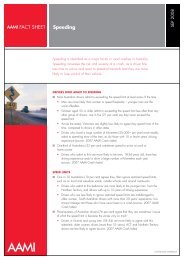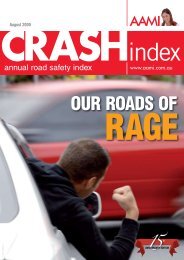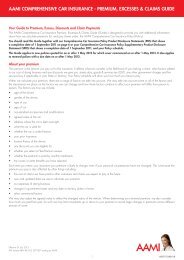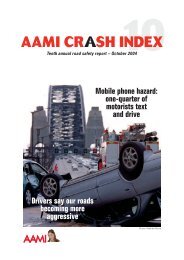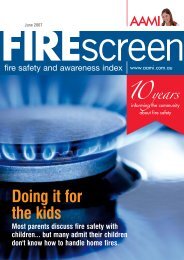2011 AAMI Crash Index
2011 AAMI Crash Index
2011 AAMI Crash Index
Create successful ePaper yourself
Turn your PDF publications into a flip-book with our unique Google optimized e-Paper software.
<strong>2011</strong> <strong>AAMI</strong> <strong>Crash</strong> <strong>Index</strong><strong>AAMI</strong> has become known for a commitment to safe driving: wereward safe drivers with discounts on their insurance, we run safedriving courses for new drivers (<strong>AAMI</strong> Skilled Drivers) and we havespent hundreds of thousands of dollars over the years researching thedriving behaviours of Australians.The <strong>2011</strong> <strong>AAMI</strong> <strong>Crash</strong> <strong>Index</strong> is the 16th safe driving index publishedby <strong>AAMI</strong> to educate and inform the community about road accidents,why they happen and how they can be prevented. A recent reportby the Bureau of Infrastructure, Transport and Regional Economicsshowed that fatal accidents have decreased steadily over the past 10years. In fact, fatalities per 100,000 people are down by 32% overthe past decade, with 1,368 deaths on our roads last year. But that’sstill 1,368 too many, and many of them are avoidable.<strong>AAMI</strong> would like to thank Professor Russell Gruen, Dr Thomas Densonand Ms Sara Gipton for their insights and their contribution to the<strong>2011</strong> <strong>AAMI</strong> <strong>Crash</strong> <strong>Index</strong>.1,368too many fatalities on our roads last yearRural DrivingDo you drive with the same style in rural areas as you do in urban areas?How do the major risks differ between urban and rural driving? ProfessorRussell Gruen, trauma surgeon at The Alfred in Melbourne and Director ofthe National Trauma Research Institute, weighs in on the topic.Green MotoringWith climate change and carbon emissions at the forefront of the nation’sagenda, we look at the environmental impacts of motoring and offersome tips on what you can do to minimise the impact of your car on theenvironment. Ms Sara Gipton, CEO of Greenfleet discusses the benefits ofgreen motoring.Driver DistractionsWhat makes us take our eyes off the road? How do distractions affect ourdriving and what are the implications on road safety? Dr Thomas Densonfrom the School of Psychology at the University of New South Wales offerssome insights on distractions based on his groundbreaking research.1
2Rural driving
Goin’ up the countryAbout 60 percent of all fatal road crashes in Australia occuron rural roads 1 , and the majority of these (68%) involve asingle vehicle 2 .While many of us are used to the stop-start nature of city driving there isa significant difference between driving on city roads and driving on ruralroads. Rural driving involves many hazards that don’t exist in urban areasand vice versa. In the city and suburbs you’re keeping an eye out for cyclists,buses, children, trams and pedestrians. Whereas kangaroos and cattle,unmarked bends and poor road quality are all commonplace once you getbeyond the city limits.Attention and DistractionOn rural roads unexpected hazards can appear quickly and with tragicconsequences. While on urban roads 40km/h school zones remind driversthat children are about, whereas beyond the city limits there is often nowarning for dangers such as wildlife, damaged roads, fallen trees andblind curves.But it is often the distinct lack of obvious hazards that is the greatest dangeron rural roads. Those long, straight stretches lend themselves to daydreaming, fiddling with your iPod or admiring the scenery. Drift onto theverge at high speed and you could easily lose control of your vehicle.60%of all fatal road crashes in Australia occur onrural roads“ Because regional driversare often travelling faster,the impact of any collision isgreater and resulting injuriesare more severe.”Surgeon at The Alfred and director of the hospital’s National TraumaResearch Institute, Professor Russell Gruen says fatigue is a key contributingfactor in single car collisions. “Together with speed and varying roadconditions, they remain the biggest challenges for regional drivers.”Thankfully, 78% of Aussie drivers pay more attention when they’re on ruralroads, particularly people who live in capital cities. Victoria sees the biggestdifference in attitude with 17% more people in Melbourne saying they paycloser attention to rural roads than those who live outside the capital.Women are more likely than men (81% versus 75%) to pay more attention totheir driving in rural areas, while females are also more likely (36%) to limittheir distractions on rural roads than men do (29%).Alarmingly, some 16% of drivers don’t feel the need to adjust their drivingwhen conditions deteriorate.Professor Russell GruenNational Trauma Research InstituteProfessor Gruen warns that unsafe behaviours on rural roads can lead toerrant drivers paying a high price. “Drivers injured on regional roads oftenhave to wait longer for paramedic and hospital intervention, and criticalinjuries are therefore left untreated longer.1 www.infrastructure.gov.au/roads/safety/publications/2009/pdf/RSRG_2009005.pdf2 BITRE: Fatal crashes in Australia in the 1990s and 2000s: crash types and major factors3
Speed on Rural RoadsSpeed is a strong contributor to fatal incidents, accounting for more thana third of fatalities in 2010 3 . Despite this, 20% of drivers <strong>AAMI</strong> surveyedbelieve it’s okay for them to speed a little in the country because they knowthe roads.Another concerning statistic is that only 40% drive under the speed limitwhen on a rural road. Our most speed-conscious state by far is Tasmania,with 54% driving under the speed limit on rural roads while only 35% ofQueenslanders choose to slow down.Professor Gruen said, “It’s common for drivers on regional roads to betravelling faster, for greater distances, than city drivers.“Because regional drivers are often travelling faster, the impact of anycollision is greater and resulting injuries are more severe.“Drivers who spend time on regional roads should avoid becoming a statisticby staying alert, being sensible about speed, expecting the unexpected and,of course, avoiding alcohol and drugs”, he concluded.3 National Road Safety Council, 2010When driving on rural roads incountry areas...0 10 20 30 40 50 60 70 80I pay more attention to the road78%I drive under the speed limit40%I increase the distance between myvehicle and the vehicle in front of me70%I limit any distractions32%I speed a little because I know the roads20%I can have a few drinks and then drivebecause I know the roads6%I know the roads, so I don’t feelthe need to adjust my driving whenconditions deteriorate16%It is city drivers that cause the problems,not local drivers24%4
TOPTIPS for safe driving on rural roads1. Don’t just drive to the speed limit – drive to theconditions. That means both the weather and thestate of the roads you’re driving on.2. If you don’t know what is over the rise or around thebend, slow down and be prepared for anything.3. Don’t be lulled by long open stretches of road. Limityour distractions and stay alert.4. Wear your seatbelt. Always. It often makes thedifference between surviving a crash and not.5. If you are driving long distances, take a breakoutside the vehicle every couple of hours. Share thedriving if you can.6. The most likely time for animal collisions is dusk anddawn. Be extra vigilant.of drivers surveyed believe it’s okay for themto speed a little in the country because they20% know the roads5
6green motoring
It IS easy, being greenClimate change and the degree to which our day-to-day livesare affecting it is one of the most debated topics of this decade.And the introduction of Carbon Tax legislation in Australia thisyear put the subject of carbon emissions front and centre.Australia is a fair old size and collectively we drive more than 225 billionkilometres a year 4 across the many roads and byways of Oz.Sara Gipton, CEO of environmental organisation Greenfleet, notes that:“Passenger vehicle emissions account for more than half of all transportemissions in Australia and have grown steadily year upon year 5 . There arenow more than 12 million passenger vehicles on Australia’s roads and eachcar on average is pumping out nearly four CO 2e tonnes every year.”Carbon emissions associated with vehicles are typically the largest source ofair pollutants in urban areas. The good news is that the <strong>2011</strong> <strong>AAMI</strong> <strong>Crash</strong><strong>Index</strong> shows half of Australian drivers consider environmental factors whenpurchasing a new vehicle. These factors include air pollution rating and fuelconsumption.While women (54%) are a little more concerned than men (48%), it’s theover 50s (61%) who are most likely to take into account environmentalfactors when buying a new car.225bnthe number of kms driven byAustralians last yearAcross Australia, the most environmentally considerate state is Victoria, withalmost 60% considering the environment when purchasing a car. Victoriansare followed by South Australians at 52% and the Western Australians at51%. While only 42% of Tasmanians consider factors such as fuel efficiencyand air pollution ratings when purchasing a car.What can you do?It’s not viable to purchase a new car every time a new way is discovered toreduce the emissions from your car. However, there are things we can all doas drivers to help minimise the environmental impact of getting from A to B,and it starts with asking yourself if you even need to use the car to get from Ato B. Could you walk, cycle or take public transport?Almost half of us (46%) admit to using the car when there are alternativeways of getting from A to B. Adelaide drivers are most likely to use the carwhen they don’t really need to (57%), followed by Perth drivers (55%), whileSydney drivers were most likely to use alternative means of transport.Removing unnecessary weight from your car is another easy way to drivegreener and more than 40% of Australian drivers already do this. Excessitems such as roof racks and luggage in the boot can weigh down yourvehicle, meaning it requires extra fuel to power the car. If you’re not using4 Australian Bureau of Statistics, Survey of Motor Vehicle Use, August <strong>2011</strong>.5 www.climatechange.gov.au/publications/projections/australias-emissions-projections/transport-emissions.aspx7
these items, remove them. It will not only cut your petrol bill, it’s also betterfor the environment in the long run.There is also something to be said for adjusting your driving style orbehaviour. Thirty-seven percent of those <strong>AAMI</strong> surveyed say they adjust theirdriving behaviour to reduce the impact of their car on the environment. Andthe best thing you can do in this respect (aside from hopping on your bicycleor legging it instead) is become a smooth operator, as Sara Gipton discussesin her Top Tips.More than three quarters (77%) of Australian drivers say they accelerate andbrake smoothly. That said, Northern Territorians have the heaviest feet, withonly 66% braking and accelerating smoothly. Drivers in New South Walesuse the inertia in their cars most efficiently, with 80% of drivers telling us theydrive smoothly.Driving at high speeds also burns excessive fuel and 60% of Australiandrivers avoid driving at high speeds or in a higher gear than is necessary.When the rubber hits the roadMaintaining the right tyre pressure can have an effect on the fuel efficiency ofyour car. If your tyres don’t make proper contact with the surface of the roadit takes more energy to move the car. Thankfully, seven in ten Australiansunderstand the environmental importance of maintaining the right tyrepressure and check them regularly.Under inflation Correct inflation Over inflationThe right tyre pressureExcessive shoulderwearEvenwearExcessive centrewearReplacing your tyres more often than necessary can also have a negativeimpact on the environment, so ensuring even wear will help your tyres lastlonger and reduce your environmental impact.Carpooling – sharing is caringIt’s one of the cheapest and most effective forms of transport, the good oldfashioned carpool. Currently, only a quarter of Australians carpool whenpossible. Car pooling is a great way to save fuel (and therefore pollution) andreduce congestion and it means you don’t have to buy, maintain and parkanother car.Sara Gipton says it works best when you have regular routes such as school,work or uni. “Find people who travel the same routes at about the same timeas you do. Your workplace or school should be able to help with this. If theycan’t, offer to help them set up a plan, as there are likely to be others whoare interested.“Like everything, there are same basic rules to follow to make it work: be ontime, keep the vehicle clean, let people know if your plans change and agreeany payments before the trip. For work vehicles, return it in the condition youfound it, which means full tank and clean.”86 www.environment.gov.au/atmosphere/airquality/publications/sok/execsummary.html
Sara Gipton is the CEO of Greenfleet, a not-for-profitorganisation dedicated to helping the community reduce theenvironmental impact of travel, business and lifestyle choices byadopting low-carbon alternatives and biosequestration.Sara GiptonCEO of Greenfleet“Every new car sold in Australia is rated for fuel efficiency and the amountof greenhouse pollution that it generates for every kilometre travelled. Youcan find out the rating of your car on the Green Vehicle Guide website(www.greenvehicleguide.gov.au). The Australian Government also releasesdata on how far we all drive and how much fuel we use and from this wecan work out our overall performance.On average, Australian passenger vehicles are generating approximately290 grams of CO 2for every kilometre travelled. The good news is that thisaverage has been slowly decreasing over the last decade, which means theAustralian fleet is becoming more efficient – but there are more cars on theroads, so our overall emissions are increasing. New cars sold in Australia in2010 averaged 220g/km, which will slowly improve the performance of thefleet over time, but let’s put this in an international context.In 2007, the European Union mandated that every new car sold from2015 must meet an average of 130g/km, and 95g/km by 2020 (that’smore than twice as efficient as the current Australian fleet). Manufacturerswill be penalised when they don’t meet this average. Likewise, the Obamaadministration in the United States has just imposed similar efficiencyof the over 50s are most likely to take intoaccount environmental factors when buying61% a new carstandards on all light vehicles: on average, all light vehicles sold must meetthe 100g/km target by 2025. So we can expect the major manufacturers ofvehicles across world markets to build more efficient vehicles for us to drive,which is great news. However, it makes us realise how much more we canimprove the efficiency of the fleet (and save money) if we could reach thesestandards. The Gillard Government has announced that vehicle efficiencystandards will be set for 2015, but the target is still being negotiated.So how do we improve the greenhouse performance of Australia’s vehicles?The pollution is a product of how far we drive and how much fuel we use totravel any distance. We can save money and reduce pollution by planningtrips and sharing rides, so overall we drive less. But the reality is, people stillneed cars. So until you change over your car – remembering to look at thegreenhouse rating of the vehicles you are considering when you do – drivingas smoothly as you can, ensuring your vehicle is well maintained (includingkeeping the tyres to pressure) and removing any excess weight from thevehicle all makes a difference.And of course, we encourage everyone to offset the emissions their cargenerates by planting Australian forests with Greenfleet. ”9
TOPTIPS for green drivers• The best way to save money and to help the environment inthe car you have today is to drive smoothly. Smooth, but notnecessarily slow, driving makes a huge difference to how faryou can go on a tank. Look as far as you can up the roadso you can anticipate what road conditions are ahead andleave a little more space between you and the next car. Youwill find you won’t need your brakes as much and you cancope with changes in traffic better. ‘Zero’ your trip meterevery time you fill the tank and see if you can beat yourpersonal best.• Keep your tyres at the right pressure. Try riding a bikewith under inflated tyres then pump them up and feel thedifference. It’s the same in your car. Not only is it saferbut keeping your tyres at the right pressure will save youapproximately 3% of the annual fuel cost for every PSI itis under inflated. You may like to reinvest the saving byoffsetting your emissions with Greenfleet.• Racing off at traffic lights or the even crazier accelerating toa red light or a stop sign is a great way to waste money andgenerate emissions.All these little things can make a huge difference, with mostpeople finding they can save between 10 – 20% off the cost oftheir fuel bill and that’s 10 – 20% fewer emissions.10
Road Rage, Distraction & Speed11
Can’t we all just get along?Stress levels run high while we’re on the road. If someone walksin front of you in the street you probably roll your eyes and keepwalking. But, if someone cuts you off in traffic, a few choicegestures and language to make a sailor blush all too oftenfollow. In fact, <strong>AAMI</strong>’s research shows 86% of motorists feeldrivers are becoming more aggressive.It’s common to be subjected to rude or aggressive driving behaviours,especially when traffic congestion is up. So how should we respond to suchbehaviour? When asked what the best response to such behaviour was,some 87% said you should ignore the other driver completely or signal anapology and concentrate on driving. Only 3% suggested a rude signal orverbal abuse might be appropriate, while a mere 1% voted for tailgating.But what actually happens when you’re behind the wheel is a very differentstory. Half of Australian drivers have admitted to yelling and swearing atanother motorist for doing something they thought was rude or dangerous.Thirty-eight percent of drivers admit to delivering less than polite signlanguage. More worryingly, 18% of drivers have become so angry with theactions of another motorist that they have deliberately tailgated them, anaction that dramatically reduces their ability to avoid a collision and putsboth themselves and other drivers at risk. And they’re largely unapologetic.say you should ignore the other driver orsignal an apology when subjected to rude or87% aggressive driving behaviour, but...• Of the 50% of drivers who have verbally abused another driver for doingsomething they felt was rude or dangerous, 82% felt it was justified.• Of the 38% of drivers who have gestured rudely, 81% feel their responsewas justified.• Of the 18% of drivers who have been so angry they’ve tailgated, 66%feel it was justified.What is truly frightening is what more innocuous responses such as verbalabuse and rude gestures can lead to. Nearly a quarter of drivers (23%)surveyed say they’ve been followed by a rude or aggressive driver they hada run-in with. Ten percent have been forced off the road, while 2% havebeen physically assaulted.Those ‘best practice’ responses to rude or aggressive behaviour – ignoring itor signalling an apology – really are the best and safest response.Responses when encounteringa rude or agressive driverResponseJustified?0% 20% 40% 60% 80% 100%Rude guesturesSworn/Yelled38%81%50%82%Tailgated18%66%12
Driven to DistractionOf the 24% of drivers who have been involved in collisions in the last fiveyears, nearly a quarter of them (23%) blame inattention or distraction for theircrashes. But what is it that is actually making us take our eyes off the road?As a nation, it’s mostly children in the car that are keeping us fromconcentrating on the road, with 35% of drivers noting that the kids distractthem. If we look at the distractions across the country, it’s a different story.South Australian, Western Australian, Queensland and Victorian kids arekeeping mum and dad from focussing on the road. While in New SouthWales they are more interested in where they are going, choosing to focuson their Sat Nav. Tasmanians and those in the Territories are more interestedin the entertainment for the journey, letting the CD Player, Radio or MP3player distract them from keeping their eyes on the road.A lot can happen in the few seconds your eyes are focussed on your iPod,Sat Nav or the kids arguing in the back seat: a child can step into your path,a roo can hop onto the road in front of you or you could drift onto the vergeand lose control. Nothing is more important than focusing on your drivingand the traffic around you.SpeedingState and territory governments across the country spend tens of millionsof dollars on speed awareness campaigns annually. In many cases thesecampaigns are targeted towards young males. Even though we tend toof those involved in collisions in the last fiveyears blame inattention or distraction for their23% crashesblame the young drivers for speeding (59% of drivers aged 18-24 ‘addGST’ to the speed limit), the <strong>AAMI</strong> <strong>Crash</strong> <strong>Index</strong> has found that the other agegroups are just as at-fault with 56% of the 25-49 year olds and 42% of theover 50s exceeding the speed limit by more than 10km/h.It is a common belief that it is okay to exceed the speed limit by just a fewkilometres per hour, in fact 90% of the driving population admit they do thisat least some of the time. But what difference could a few kilometres possiblymake? The reality is that a driver travelling 5 km/h above a 60 km/h speedlimit doubles his or her risk of being involved in a casualty crash 7 .There is no place for speeding on our roads, at any age or in any location.7 www.casr.adelaide.edu.au/speed/vol-1.htmlThe need for speedExceed speed limit by> 10kms/hr0% 10% 20% 30% 40% 50% 60% 70%NationalNSW50%52%VIC44%QLD56%SA44%WATAS52%53%ACT61%NT49%13
The <strong>AAMI</strong> <strong>Crash</strong> <strong>Index</strong> has highlighted what is distractingdrivers or what winds them up, but what effect does road rageand distraction have on us while we’re driving? What is thebehavioural result of these influences?A team of researchers, including Dr Tom Denson, Associate ProfessorMichelle Moulds, and Jesse Hancock from the School of Psychology at theUniversity of New South Wales and Dr Lisa Zadro from the University ofSydney are currently conducting a 3-year investigation into road rage, driverdistraction and driving anxiety to answer those very questions.Dr Tom DensonSchool of Psychology at theUniversity of New South WalesThe project, which is co-funded by <strong>AAMI</strong> and the Australian ResearchCouncil, utilises a state-of-the-art driving simulator in which participants areexposed to pre-scripted triggers designed to evoke anger.“When people experience road rage, they may not only be a dangerto others, but also to themselves. Anger increases blood pressure andheart rate, which prepares the body for action, what psychologists calla physiological ‘fight response’. In our hunter-gatherer past, anger wasprobably a pretty effective means of scaring off enemies, facilitatingaggression and obtaining resources but in today’s modern world frequentanger is a risk factor for early mortality due to cardiovascular disease and inthe car can lead to accidents. With alarming numbers of Australian motoristsadmitting to experiencing road rage, my colleagues and I are concernedabout the mental and physical health ramifications.“When we cut someone off, it is because we are in a hurry; whensomeone else does it to us, it is because they are a jerk.”We are focussing on young drivers in particular, as road accidents are aleading cause of death among young people. Testosterone concentrationsare greatest in young males under 30 years old. The hormone has beenimplicated in dominant-seeking behaviour, aggression and risky decisionmaking in both men and women. When people are angered, testosteronelevels increase, which could increase risky and aggressive driving. We arecurrently examining this possibility.Because of the way we think, road rage is often difficult to avoid. When wecut someone off, it is because we are in a hurry; when someone else doesit to us, it is because they are a jerk (or worse). Being aware of this andother factors that can increase aggressive driving and anger is a first steptoward reducing road rage. An ongoing experiment is investigating theindividual and combined effects of aggressive music and distraction on riskyand aggressive driving and physiological reactions. Laboratory experimentsshow that songs with aggressive lyrics increase anger and aggression. Ourdesign will allow us to determine whether aggressive driving is the result ofthe aggressive lyrics or distracting nature of the music or both.Upcoming experiments will examine the role of being angered – such asby one’s boss – prior to getting in the car; another will investigate howindividuals who are anxious about driving respond behind the wheel. ”14



